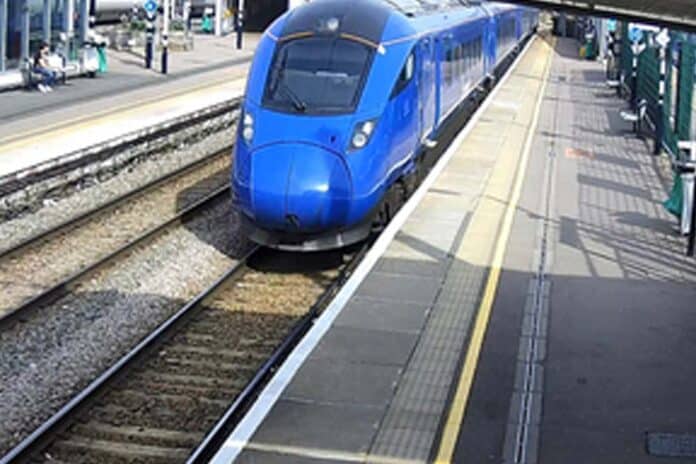RAIB has released statements on two incidents which took place earlier this year.
The most recent of the two was an overspeeding incident in Peterborough in Cambridgeshire.
At around 10:20 hrs on 17 April 2022, the 08:20 hrs Newcastle to King’s Cross service, operated by Lumo, passed over three sets of points at the north end of Peterborough station at a speed of 75 mph (121 km/h). This was above the maximum permitted speed limit for these points of 25 mph (40 km/h). Passing over the points at this speed meant that the train suddenly lurched sideways.
The sudden movement of the train resulted in some passengers being thrown from their seats and in luggage falling from the overhead storage in the passenger compartments. This resulted in a number of minor injuries being sustained by passengers.
The train subsequently came to a stand beyond the far end of Peterborough station. The train did not derail during the incident, and no damage was caused to the infrastructure of the railway, or to the vehicles involved.
RAIB says the train involved in the incident was not due to call at Peterborough and had originally been approaching the station on a fast line, before being routed onto a slower line via the points where the overspeed occurred. The route onto this slower line was being displayed on the signal situated on the approach to the points.
RAIB’s investigation will seek to identify the sequence of events which led to this incident. It will include consideration of:
- the way in which the train was driven
- any factors which may have influenced the actions of the driver of the train
- the condition of the signalling system at the time of the incident
- the nature of the reported injuries
- any underlying management factors.
Meanwhile, RAIB has issued some safety messages after a ‘trap and drag’ incident – when a customers hand was caught in the door and the train started moving.
On this instance, on 14 January at 08:22, a passenger became trapped in the doors of a train which was about to leave platform one at Wood Street station. The train then started to depart from the platform, forcing the passenger to run alongside it.
The train involved in the incident was the 08:14 hrs Arriva Rail London (ARL) service from Chingford to London Liverpool Street. It comprised two class 710 Aventra electric multiple units, each of four cars. Passengers cannot pass between the front and rear four-car units without leaving the train.
Platform CCTV from Wood Street station shows that the passenger involved in the incident had initially got out of the rear door of the fifth car after the train arrived at Wood Street station. She then attempted to board the train again using the rear doors of the fourth car, after the door closing sequence had begun. As she attempted to board the train, the passenger placed her hand between the closing doors. After the doors closed, the passenger was left standing next to the train, with her hand trapped between the closed doors. The train then started to depart from the platform with the passenger’s hand still trapped in the doors.
The train stopped after it had travelled for around 20 metres along the platform, having reached a maximum speed of 7.6 mph (12 km/h). After the train stopped, the passenger was able to free her hand from the doors. It was reported to RAIB that the passenger did not sustain any injuries and that she left the station after speaking to the train driver.
RAIB says This incident occurred because the driver did not appreciate that the passenger was in an unsafe position when he made the decision that it was safe to start the train.
The driver stated that, although he had seen that the passenger was close to the side of the train before starting the train, he was unaware that she was trapped in the doors and believed that she was pressing the ‘door open’ button to try and board the train.
The station platforms at Wood Street are not staffed and drivers are responsible for dispatching trains from this station; they carry this out using body mounted CCTV.
Furthermore, it is not possible for the driver of a class 710 train to apply traction power if the door interlock, an electrical circuit which confirms that all doors are fully closed and locked, has not been obtained. The driver will receive an indication that the interlock has been achieved via an indicator light in the driving cab.
An anti-obstruction mechanism means that most objects would force the doors to reopen – but not necessarily anything as thin as hands or a bag strap.
For this reason, drivers are warned in ARL’s dispatch instructions that obtaining a door interlock only indicates that the doors have completed the closure sequence and not that it is safe to depart.
The doors and interlock system of the train involved were tested after the incident and were found to comply with the applicable ARL standards.
The driver later stated that he did not believe that the passenger could have been trapped in the doors when he started the train, because he had obtained door interlock. RAIB says this suggests that the driver was, in these circumstances, using the interlock to indicate whether it was safe to start the train.
As a result, RAIB has issued the following advice on the importance of:
- being aware of the potential hazards if a train moves when people are in close proximity
- carrying out a thorough final safety check and not relying on the interlock system as proof that it is safe to move a train – these systems are not always capable of detecting objects trapped in closed and locked doors







































 0113 2082620
0113 2082620 info@railbusinessdaily.com
info@railbusinessdaily.com 15 Mariner Court, Wakefield WF4 3FL
15 Mariner Court, Wakefield WF4 3FL

